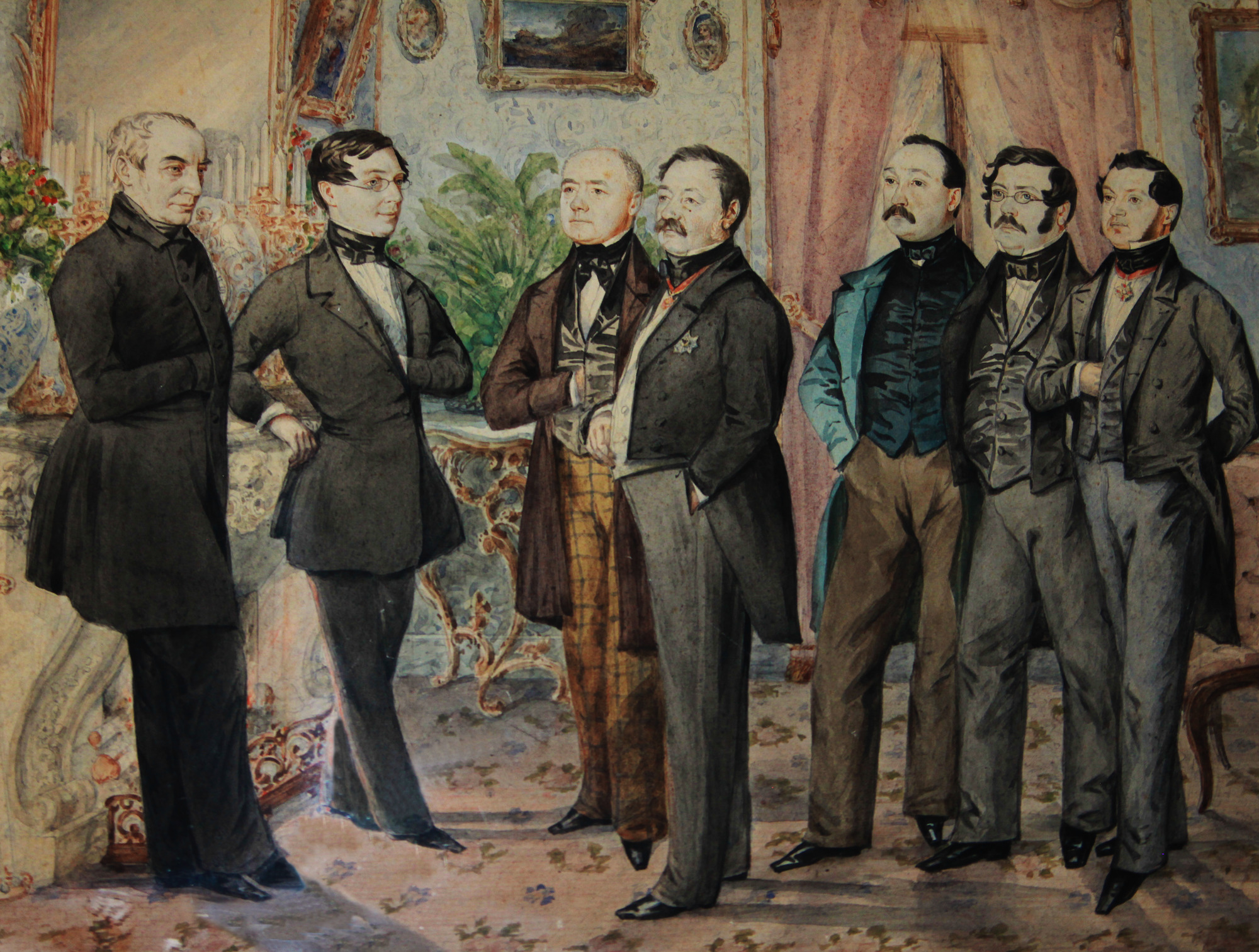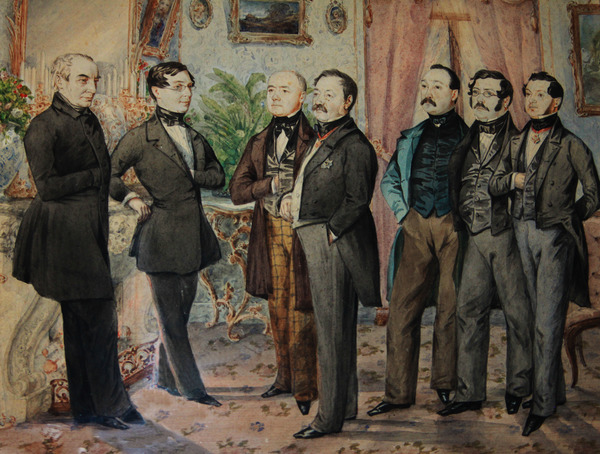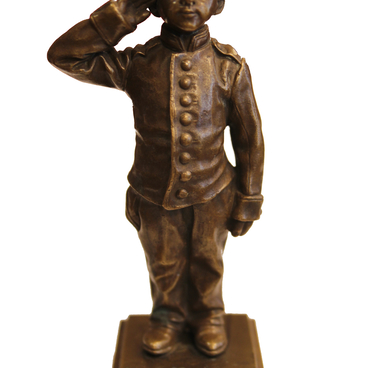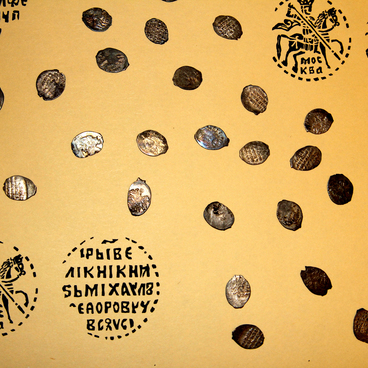The picture portrays Kaluga officials of the mid-19th century. At that time lots of positions in the governorate were assigned to those who were not of noble origin but were allowed to enter the civil service due to their brilliant education, for instance. Noblemen by birth hardly accounted for a third of the Kaluga Administration – however, they held almost all senior positions.
#1
Unknown author
Kaluga officials
#3
#5
One of the civil servants in the picture was Nikolai Smirnov.[1] He was born to the family of a guards officer, was brilliantly educated and at the age of 17 he entered the Moscow Archives of the Ministry of Foreign Affairs. Then he had a three-year posting at the Russian Embassy in Florence, Italy, followed by two years in Berlin, Germany. In 1842, Smirnov was transferred to the Ministry of the Interior at his own request, and in 1854 appointed the civil governor of Kaluga.
During his term of office, Kaluga’s cultural life was thriving. The Governor personally knew Alexander Pushkin. His house was frequented by Nikolai Gogol, Vissarion Belinsky and Alexei Tolstoy. Upon Smirnov’s initiative the city established an industrial and agricultural exhibitions, which displayed items produced at ‘factories, plants, by craftsmen, and products of agriculture and cropping farms’ and also specimens of ‘remarkable soils, minerals, fossils and all sorts of ancient items found in the province’. Owing to the governor, they planted out the Berezuyevsky Gully with trees and shrubs, opened the Golden Alley, a popular walking spot, surfaced streets and removed merchant’s stalls from the Stone Bridge and by so doing opened the view to the Oka-River. Smirnov also managed to obtain an authorization from Nicholas I to organise Kaluga’s first museum.
However, men of dignity in high positions in the governorate were few and far between. For example, retired lieutenant Alexander Yakovlev was in charge of the criminal chamber without obtaining any legal training. Publicist Ivan Aksakov, who worked for some time under Yakovlev, described him as follows: ‘narrow-minded, poorly qualified but seems resourceful, a gambler, married into money (which Smirnov dislikes a lot, as he told me). In the chamber, he seems good for nothing…’
Education was a weak spot for most of Kaluga’s civil servants in the 19th century. The statistics of those years show that only 17 per cent of local officials had higher or secondary education, and only 41 per cent managed to finish district religious or public schools. Thus, over half of the governorate staff had rather scant knowledge.
In terms of morals, Kaluga officials were no different from their peers in other governorates. Many of them were slow at addressing cases, did their duties in bad faith and even stole from the public purse. Historians believe that one of the reasons for such attitude to their duties was their poor financial situation: most of them were very badly paid, and some of them served without any salary.
During his term of office, Kaluga’s cultural life was thriving. The Governor personally knew Alexander Pushkin. His house was frequented by Nikolai Gogol, Vissarion Belinsky and Alexei Tolstoy. Upon Smirnov’s initiative the city established an industrial and agricultural exhibitions, which displayed items produced at ‘factories, plants, by craftsmen, and products of agriculture and cropping farms’ and also specimens of ‘remarkable soils, minerals, fossils and all sorts of ancient items found in the province’. Owing to the governor, they planted out the Berezuyevsky Gully with trees and shrubs, opened the Golden Alley, a popular walking spot, surfaced streets and removed merchant’s stalls from the Stone Bridge and by so doing opened the view to the Oka-River. Smirnov also managed to obtain an authorization from Nicholas I to organise Kaluga’s first museum.
However, men of dignity in high positions in the governorate were few and far between. For example, retired lieutenant Alexander Yakovlev was in charge of the criminal chamber without obtaining any legal training. Publicist Ivan Aksakov, who worked for some time under Yakovlev, described him as follows: ‘narrow-minded, poorly qualified but seems resourceful, a gambler, married into money (which Smirnov dislikes a lot, as he told me). In the chamber, he seems good for nothing…’
Education was a weak spot for most of Kaluga’s civil servants in the 19th century. The statistics of those years show that only 17 per cent of local officials had higher or secondary education, and only 41 per cent managed to finish district religious or public schools. Thus, over half of the governorate staff had rather scant knowledge.
In terms of morals, Kaluga officials were no different from their peers in other governorates. Many of them were slow at addressing cases, did their duties in bad faith and even stole from the public purse. Historians believe that one of the reasons for such attitude to their duties was their poor financial situation: most of them were very badly paid, and some of them served without any salary.
#6
Municipal Cultural Center House of G.S. Batenkov
read morehide
00:00
00:00
1x
Kaluga officials
Creation period
1851
Dimensions
28x35 cm
Technique
Watercolour
Exhibition
0
Open in app
Share



